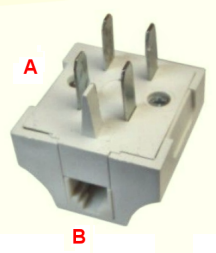Top Qs
Timeline
Chat
Perspective
WT-4
Polish telephone plug From Wikipedia, the free encyclopedia
Remove ads
WT-4[1] (adopted as ВТ-4[2] in the USSR[3]) is a Polish telephone plug used to connect telephone sets to the network. Introduced in the second half of the 20th century and adopted in several Eastern Bloc countries as a standard[citation needed]. It has since been replaced by the RJ-11 standard. Sockets are labelled with the text GTN-4[4] (РТШ-4 in the USSR[3]).


WT-4 plugs consist of 4 metal pins with an additional plastic pin at the bottom to prevent inserting the plug the wrong way round. When the plug is inserted into a socket, the plastic pin also disconnects a 1μF capacitor built into the socket. When connected, the capacitor simulates a telephone set with the handset hung up. This allows for the testing of the line even when the subscriber doesn't have a telephone connected to the network. In the mid-1990s, installations of WT-4 plugs began to be phased out, and the standardized shape of the socket was used to install RJ-11 connectors instead.

A rare 6-pin version also existed, called WT-6.[5] Extra pins (numbered with the missing 1 and 2) were located between the existing pins 3 and 5, and 4 and 6, respectively. These extra pins were used for powering telephone sets with illuminated rotary dials, as well as some more advanced telephone installations.
Remove ads
See also
References
- Biuletyn Informacyjny Teleelektroniki, nr 2 / 1974
- Schemat telefonu Aster (prod. Radomska Wytwórnia Telefoniczna)
- Schemat telefonu CB-662 z podświetlaną tarczą
Notes
Wikiwand - on
Seamless Wikipedia browsing. On steroids.
Remove ads

